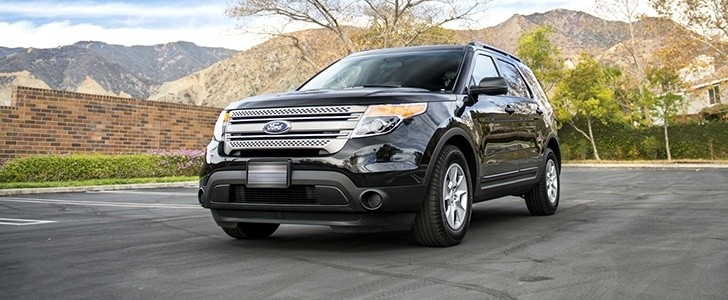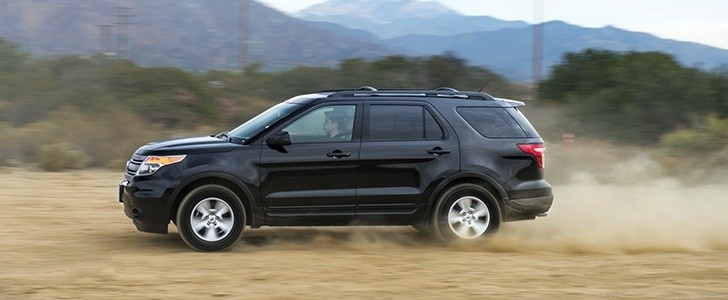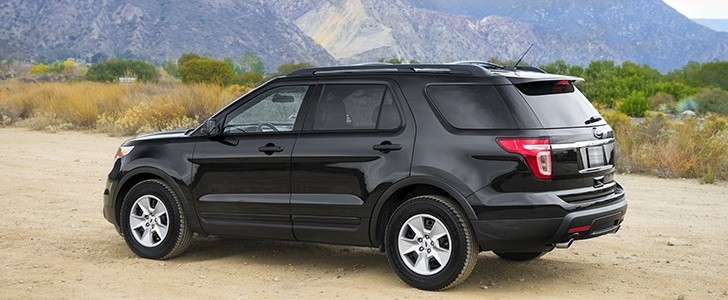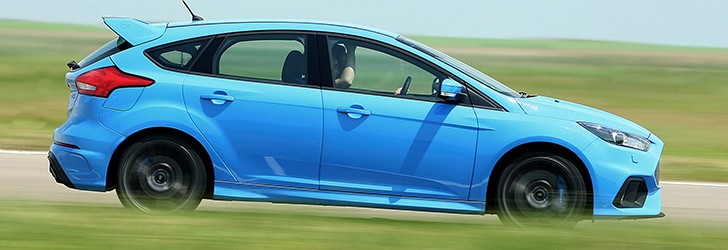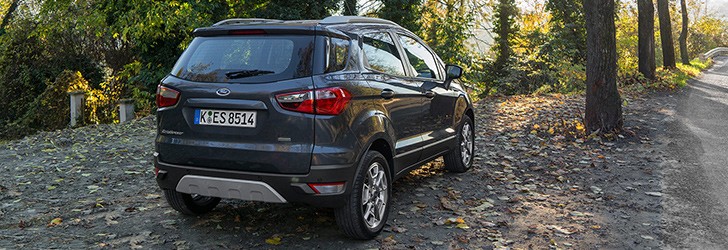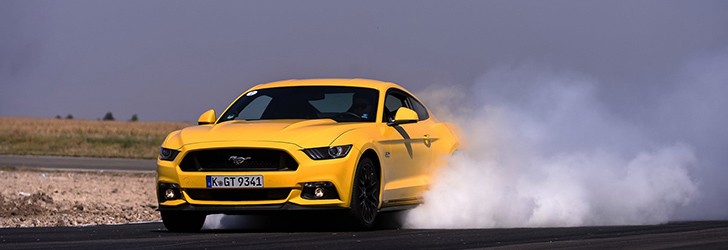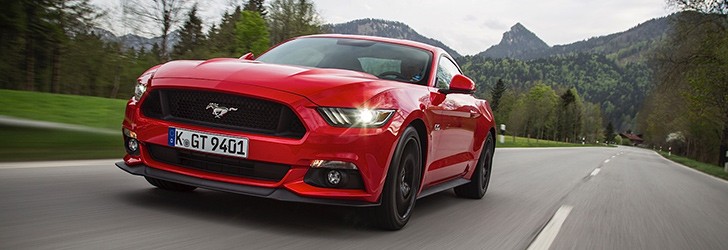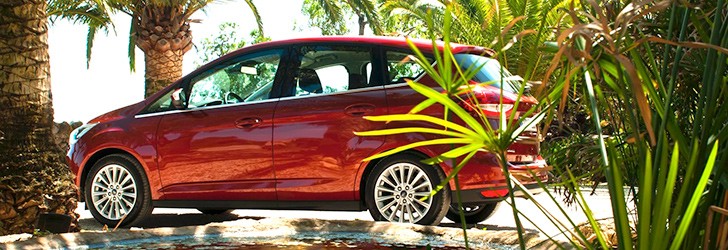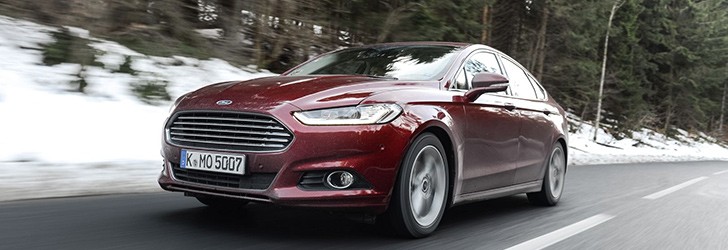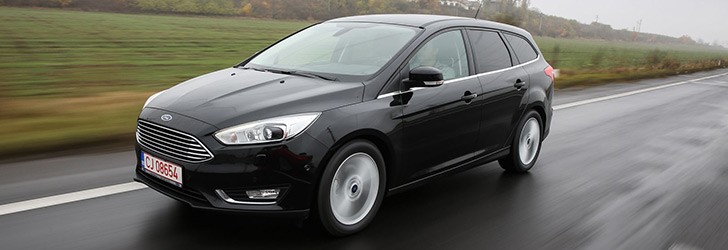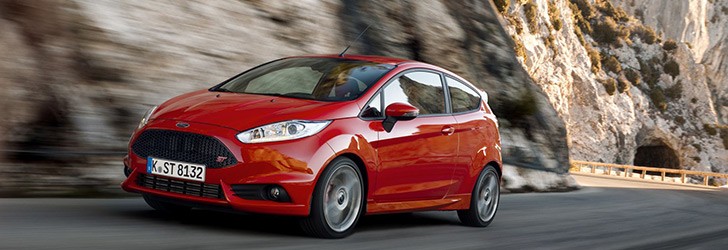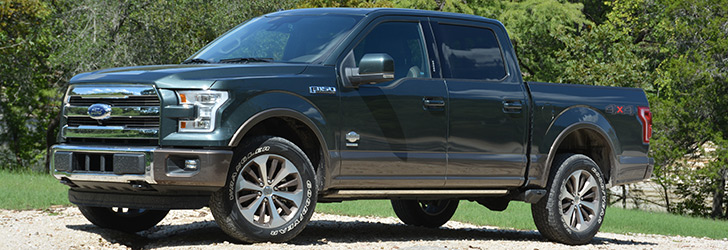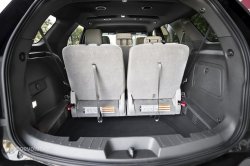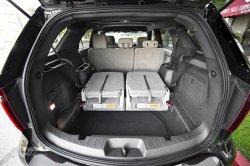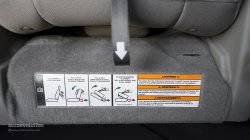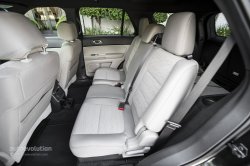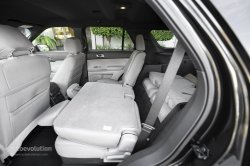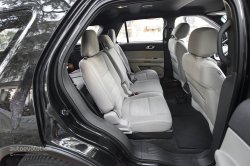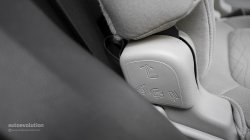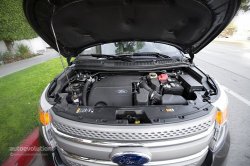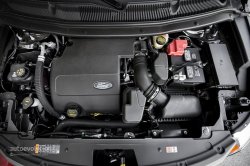2014 FORD Explorer Review
OUR TEST CAR: 2014 FORD Explorer 3.5L V6 FWD 6-speed Automatic
For many people, vehicles are vehicles and all it matters is how they feel, not if they’re SUVs, CUVs or Whatevers. With the new Explorer, Ford is playing a game related to this reasoning by offering us a crossover labeled as an SUV.
Then again, all other choices the Blue Oval made when conceiving the new Explorer were the obvious ones. First of all, the transition from a separate chassis to a unibody construction was required by the market. Fewer and fewer people want to deal with the efficiency, dynamic and comfort drawbacks brought by a ladder chassis, only to exploit its towing and rugged terrain premiums.
As for the designation, Ford considered re-baptizing the vehicle after the 2000s Firestone rollover dark story that stained the nameplate, but eventually found out that the awareness for the name was huge, so it decided to keep it.
While they were at it, Ford wanted their new Explorer to grab some attention, so they turned to the sporty side for styling. Does this mean the vehicle should actually be called a SLCUV (sporty-looking crossover utility vehicle)? Err... no, but it does draw attention to the model, which is precisely what increased our curiosity as we were approaching our 2014 Ford Explorer tester.
Ford is currently pursuing multiple design directions and when it comes to the Explorer, the matter falls in line with the Taurus. Perhaps this is why the two make a good-looking police interceptor pair, but that’s another story.
There are plenty of visual tricks that generate the aforementioned dynamic styling conclusion. Some of these are related to other Ford models, such as the Mustang-like wheel arches. These are part of what we’d call complex side styling. Others are traditional Explorer treats, such as the blacked-out B- and D-pillars. For the new model, designers also applied this trick to the A-pillar.
Truth be told, it’s not just design gimmicks that make the Explorer visually appealing - the vehicle is wider, lower and longer than its predecessor. As for the platform underneath, this is the D4 architecture, also serving the Ford Flex and the Lincoln MKT.
Again in a similar fashion to the Taurus, the door has a nice solid feel. Once you open this, a spacious interior is revealed. Up front, the driver and the passenger have all the room they want, but what really surprised us was the space in the second row. Three adults can easily go for a long trip in here.
Yes, we said second row, as the Explorer also offers a third row of seats. Access is easy, but the high floor makes the seating position rather uncomfortable.
Even though the Ford uses a more car-like approach than the Jeep Grand Cherokee, for instance, the Explorer comes with this facility, while the Jeep doesn’t. Don’t worry though, the Chrysler group has the Dodge Durango, which can be seen as an elongated Grand Cherokee, for such hauling needs. Further behind, we find a 21 cubic feet (595 liters) luggage compartment.
And since we’re comparing the Ford Explorer to the Grand Cherokee, we have to mention the latter clearly beats the former when it comes to efficiently using its cabin dimensions. The Ford comes with bulky seats, a hefty dashboard and so on.
If you go for the base trim, the tiny infotainment screen on the center console adds to the rather cheap look of certain materials, which are admittedly nice to touch (recycled materials are to blame here).
Move on to the higher spec models and you get an 8-inch color touch screen that works well. Alas, certain scenarios see you also receiving a Sony audio system that brings an unpleasant ergonomics-related implementation drawback - the climate controls become capacitive touch units that are simply a pain to use.
Also, trying to use voice control for Ford’s SYNC can sometimes confuse the system, with the result being a frustrating “talk” with the car. Luckily, the dashboard instruments are easy to read and their lighting is relaxing.
Returning to the interior room topic, Ford chose to trade the extra space that would’ve been offered by slimmer cabin furniture for the feeling of security offered by the massive elements. Truth be told, this resonates with the overall feel of the Explorer.
Engineers and designers worked together to make this a quiet and cozy car. Well, they’ve done a great job. Right now we’re in the middle of the city and the Explorer acts as a perfect shield for the urban rumble.
Despite the transition to a unibody construction, you can’t ignore the mass and dimensions of the Explorer when it comes to city driving. Still, the car does a good job at this.
When it comes to parking, Ford’s Explorer is a gentleman. First of all, you can have the car with a blind spot monitoring (BLIS) function. While later on in the drive we appreciated this on the highway, we also liked the fact that it comes with a function that assists you when backing out of a parking space with nasty visibility. Heck, if you’re lazy enough, you can even turn to the parallel parking assistant.
We drove the standard engine, which is a 3.5-liter naturally-aspirated V6 pushing 290 hp at 6,000 rpm and 255 lb-ft (346 Nm) at 4,000 rpm. When it comes to the driving part, things are quite friendly, as the throttle mapping is soft for the initial push, so you can drive relaxed.
A six-speed automatic is standard (the Jeep gets an eight-speed) and this follows the V6 unit’s calm setup. For instance, the gearbox doesn’t rush to downshift until you go over the halfway throttle point, but it’s responsive enough.
You should play to this powertrain's tune anyway, because, if you don’t, the V6 can become really thirsty, even with FWD. Otherwise, the fuel efficiency sits within the class average. Using a moderate driving style inside the city, we got 14.5 mpg (16.2 l/100 km), while driving at 75 mph (120 km/h) on the highway, the Explorer returned 10.2 mpg (l/100 km). As for the overall fuel efficiency throughout our drive, which also included more spirited driving moments, this sat at 18 mpg (13 l/100 km).
Thanks to the Ti-VCT variable intake and exhaust valve timing, the V6 has no issues with being used under 2,000 rpm, just like it’s OK with being hammered if you’re in a hurry.
Together with the high driving position, the seat gives you the impression you reign over one cozy land, where your family can enjoy plenty of peace and quiet.
Even if you don’t have the BLIS, Ford’s usual mirror-in-mirror scheme for the side units does come to assist. In fact, the Explorer is one safe car. Aside from what we’ve mentioned and active cruise control, the Ford also brings inflatable second-row seatbelts for the outboard seats on the second row, a very rare treat in the auto industry.
The Explorer passed both the NHTSA and the IIHS crash tests with flying colors, albeit with the exception of the latter’s small overlap tests. For this, the Ford swapped the “Good” rating of the others tests for a “Marginal” one.
On the road though, Ford’s Explorer feels stable at high speeds. The base version comes with front-wheel drive, but the torque steer is kept well in check. The steering is rather numb, so you won’t be tempted to hammer it through the bends anyway.
However, if you do end up entering a corner (such as a highway exit ramp) too hard, you’ll find a friend in Ford’s Curve Control system. No, this doesn’t concern female shapes, but aims to keep you healthy so you can enjoy those. You can see this as an elevated form of ESC.
ESC applies individual wheel braking to change the trajectory of the car when it doesn’t follow what the car perceives as the driver’s intention. Ford’s Curve Control does the same thing, but also focuses on reducing vehicle speed, working with all four brakes in a more serious manner. Of course, engine torque is also decreased.
This brings us to a comparo with smaller European crossovers such as the Porsche Macan and BMW X4. Both come with brake-based torque vectoring, where braking force is applied the inside wheels while the vehicle is accelerating, so that a sporty cornering feel accompanies the safety stuff. The Macan also comes with an electronically-controlled locking rear diff, but that’s another story.
The point here is that while the aforementioned Europeans focused on driving dynamics, Ford only chose to take care of the safety aspect. Oh and for the record, it’s the Blue Oval that got us comparing its SUV with Euro products, since they brag the vehicle “challenges higher-end SUVs like BMW X5 and Audi Q7”.
We’d really like to find a guy who would genuinely spend his evening choosing between the Explorer and those two - the Ford is considerably more affordable, but, naturally, also far from the Germans’ premium feel, especially Audi’s, so we don’t see them as battling for the same customers.
You can always opt for the all-wheel drive Explorer, which you’ll easily recognize before turning a wheel. That’s because next to the gear shifter, you find a knob controlling the Terrain Management System. This allows you to select between Normal, Mud and Roots, Sand, as well as Snow. And if the little car icons on the knob look a bit like Land Rover’s silhouettes, that’s because they are. The system is borrowed from the British brand, which was owned by Ford when the engineers got this idea.
When it comes to the hardware slaves working for the electronic brain, the Explorer’s AWD system is comprised of a multi-plate clutch working as a center diff and electronics impersonating locking diffs up front and at the back. Note that the system comes with updates compared to the Explorer’s platform mates, the Ford Flex and Lincoln MKT. For example, cooling was improved so that the system could be engaged for longer.
As for the ground clearance, this sits at 8.3 inches (210 mm) with the 20-inch wheel package. The same value as a Mercedes G63 AMG, for instance.
Let’s not get carried away now, this is no Discovery though. Think more Evoque.
If you terrain play within these limits, you’ll enjoy the solid feel of the thing.
This brings us to the final comparison with the Jeep Grand Cherokee and while the two are not that far away from each other, we prefer the Chrysler-made vehicle. First of all, it’s worth noting that while the Jeep was gifted with a comprehensive revamp for 2014, the Explorer only received minor model year updates, such as the one that was recently announced for 2015.
The best reason for choosing the Grand Cherokee is that this spreads its wings further in terms of powertrains. With the Explorer, you can also have a 2.0-liter Ecoboost four-cylinder producing 240 hp and 270 lb-ft (366 Nm). Then there’s the Explorer Sport, which comes with a twin-turbocharged V6 churning out 365 hp and 350 lb-ft (475 Nm).
The Jeep not only offers a diesel, but it can show the Ford what “sport” actually means, courtesy of its SRT incarnation, which is one of the sweetest SUVs we’ve ever crossed pathswith in.
Then there’s the vague overall feel of the Explorer. This Ford wants to offer everything and while it does score well in many areas, it doesn’t have the identity of the Grand Cherokee.
Don’t get us wrong, the Explorer is a truly capable proposal. First of all, it is a practical vehicle and to say that it is family friendly would be an understatement.
The fact that, in either front- or all-wheel versions, it offers a safe drive, is self-explanatory. And, to our eyes, this is one of the Blue Oval’s prettiest shells, a treat anybody will appreciate.
As for the pricing, the Ford Explorer starts at US$ US$ 30,600, with the all-wheel drive model requiring an US$ 2,000 premium . All this puts it right on par with its competitors.
Balance, this is what Ford has managed to achieve with this model. After all, such an asset is of prime importance for an actual explorer, so everything is in check.
As for the designation, Ford considered re-baptizing the vehicle after the 2000s Firestone rollover dark story that stained the nameplate, but eventually found out that the awareness for the name was huge, so it decided to keep it.
While they were at it, Ford wanted their new Explorer to grab some attention, so they turned to the sporty side for styling. Does this mean the vehicle should actually be called a SLCUV (sporty-looking crossover utility vehicle)? Err... no, but it does draw attention to the model, which is precisely what increased our curiosity as we were approaching our 2014 Ford Explorer tester.
Ford is currently pursuing multiple design directions and when it comes to the Explorer, the matter falls in line with the Taurus. Perhaps this is why the two make a good-looking police interceptor pair, but that’s another story.
There are plenty of visual tricks that generate the aforementioned dynamic styling conclusion. Some of these are related to other Ford models, such as the Mustang-like wheel arches. These are part of what we’d call complex side styling. Others are traditional Explorer treats, such as the blacked-out B- and D-pillars. For the new model, designers also applied this trick to the A-pillar.
Truth be told, it’s not just design gimmicks that make the Explorer visually appealing - the vehicle is wider, lower and longer than its predecessor. As for the platform underneath, this is the D4 architecture, also serving the Ford Flex and the Lincoln MKT.
Again in a similar fashion to the Taurus, the door has a nice solid feel. Once you open this, a spacious interior is revealed. Up front, the driver and the passenger have all the room they want, but what really surprised us was the space in the second row. Three adults can easily go for a long trip in here.
Yes, we said second row, as the Explorer also offers a third row of seats. Access is easy, but the high floor makes the seating position rather uncomfortable.
Even though the Ford uses a more car-like approach than the Jeep Grand Cherokee, for instance, the Explorer comes with this facility, while the Jeep doesn’t. Don’t worry though, the Chrysler group has the Dodge Durango, which can be seen as an elongated Grand Cherokee, for such hauling needs. Further behind, we find a 21 cubic feet (595 liters) luggage compartment.
And since we’re comparing the Ford Explorer to the Grand Cherokee, we have to mention the latter clearly beats the former when it comes to efficiently using its cabin dimensions. The Ford comes with bulky seats, a hefty dashboard and so on.
Zooming in on the dashboard, we find ourselves in a bit of a catch 22 situation.
If you go for the base trim, the tiny infotainment screen on the center console adds to the rather cheap look of certain materials, which are admittedly nice to touch (recycled materials are to blame here).
Move on to the higher spec models and you get an 8-inch color touch screen that works well. Alas, certain scenarios see you also receiving a Sony audio system that brings an unpleasant ergonomics-related implementation drawback - the climate controls become capacitive touch units that are simply a pain to use.
Also, trying to use voice control for Ford’s SYNC can sometimes confuse the system, with the result being a frustrating “talk” with the car. Luckily, the dashboard instruments are easy to read and their lighting is relaxing.
Returning to the interior room topic, Ford chose to trade the extra space that would’ve been offered by slimmer cabin furniture for the feeling of security offered by the massive elements. Truth be told, this resonates with the overall feel of the Explorer.
Engineers and designers worked together to make this a quiet and cozy car. Well, they’ve done a great job. Right now we’re in the middle of the city and the Explorer acts as a perfect shield for the urban rumble.
Despite the transition to a unibody construction, you can’t ignore the mass and dimensions of the Explorer when it comes to city driving. Still, the car does a good job at this.
When it comes to parking, Ford’s Explorer is a gentleman. First of all, you can have the car with a blind spot monitoring (BLIS) function. While later on in the drive we appreciated this on the highway, we also liked the fact that it comes with a function that assists you when backing out of a parking space with nasty visibility. Heck, if you’re lazy enough, you can even turn to the parallel parking assistant.
We drove the standard engine, which is a 3.5-liter naturally-aspirated V6 pushing 290 hp at 6,000 rpm and 255 lb-ft (346 Nm) at 4,000 rpm. When it comes to the driving part, things are quite friendly, as the throttle mapping is soft for the initial push, so you can drive relaxed.
A six-speed automatic is standard (the Jeep gets an eight-speed) and this follows the V6 unit’s calm setup. For instance, the gearbox doesn’t rush to downshift until you go over the halfway throttle point, but it’s responsive enough.
You should play to this powertrain's tune anyway, because, if you don’t, the V6 can become really thirsty, even with FWD. Otherwise, the fuel efficiency sits within the class average. Using a moderate driving style inside the city, we got 14.5 mpg (16.2 l/100 km), while driving at 75 mph (120 km/h) on the highway, the Explorer returned 10.2 mpg (l/100 km). As for the overall fuel efficiency throughout our drive, which also included more spirited driving moments, this sat at 18 mpg (13 l/100 km).
Thanks to the Ti-VCT variable intake and exhaust valve timing, the V6 has no issues with being used under 2,000 rpm, just like it’s OK with being hammered if you’re in a hurry.
As we eat mile after mile of the highway, we salute the super-comfortable feel of the standard seats.
Together with the high driving position, the seat gives you the impression you reign over one cozy land, where your family can enjoy plenty of peace and quiet.
Even if you don’t have the BLIS, Ford’s usual mirror-in-mirror scheme for the side units does come to assist. In fact, the Explorer is one safe car. Aside from what we’ve mentioned and active cruise control, the Ford also brings inflatable second-row seatbelts for the outboard seats on the second row, a very rare treat in the auto industry.
The Explorer passed both the NHTSA and the IIHS crash tests with flying colors, albeit with the exception of the latter’s small overlap tests. For this, the Ford swapped the “Good” rating of the others tests for a “Marginal” one.
On the road though, Ford’s Explorer feels stable at high speeds. The base version comes with front-wheel drive, but the torque steer is kept well in check. The steering is rather numb, so you won’t be tempted to hammer it through the bends anyway.
However, if you do end up entering a corner (such as a highway exit ramp) too hard, you’ll find a friend in Ford’s Curve Control system. No, this doesn’t concern female shapes, but aims to keep you healthy so you can enjoy those. You can see this as an elevated form of ESC.
ESC applies individual wheel braking to change the trajectory of the car when it doesn’t follow what the car perceives as the driver’s intention. Ford’s Curve Control does the same thing, but also focuses on reducing vehicle speed, working with all four brakes in a more serious manner. Of course, engine torque is also decreased.
This brings us to a comparo with smaller European crossovers such as the Porsche Macan and BMW X4. Both come with brake-based torque vectoring, where braking force is applied the inside wheels while the vehicle is accelerating, so that a sporty cornering feel accompanies the safety stuff. The Macan also comes with an electronically-controlled locking rear diff, but that’s another story.
The point here is that while the aforementioned Europeans focused on driving dynamics, Ford only chose to take care of the safety aspect. Oh and for the record, it’s the Blue Oval that got us comparing its SUV with Euro products, since they brag the vehicle “challenges higher-end SUVs like BMW X5 and Audi Q7”.
We’d really like to find a guy who would genuinely spend his evening choosing between the Explorer and those two - the Ford is considerably more affordable, but, naturally, also far from the Germans’ premium feel, especially Audi’s, so we don’t see them as battling for the same customers.
You can always opt for the all-wheel drive Explorer, which you’ll easily recognize before turning a wheel. That’s because next to the gear shifter, you find a knob controlling the Terrain Management System. This allows you to select between Normal, Mud and Roots, Sand, as well as Snow. And if the little car icons on the knob look a bit like Land Rover’s silhouettes, that’s because they are. The system is borrowed from the British brand, which was owned by Ford when the engineers got this idea.
When it comes to the hardware slaves working for the electronic brain, the Explorer’s AWD system is comprised of a multi-plate clutch working as a center diff and electronics impersonating locking diffs up front and at the back. Note that the system comes with updates compared to the Explorer’s platform mates, the Ford Flex and Lincoln MKT. For example, cooling was improved so that the system could be engaged for longer.
As for the ground clearance, this sits at 8.3 inches (210 mm) with the 20-inch wheel package. The same value as a Mercedes G63 AMG, for instance.
Let’s not get carried away now, this is no Discovery though. Think more Evoque.
To put it shortly, the Explorer can go past soft-roading level, but it’s best to stick to moderate off-roading, if you don’t want to get stuck or damage the underbody, that is.
If you terrain play within these limits, you’ll enjoy the solid feel of the thing.
This brings us to the final comparison with the Jeep Grand Cherokee and while the two are not that far away from each other, we prefer the Chrysler-made vehicle. First of all, it’s worth noting that while the Jeep was gifted with a comprehensive revamp for 2014, the Explorer only received minor model year updates, such as the one that was recently announced for 2015.
The best reason for choosing the Grand Cherokee is that this spreads its wings further in terms of powertrains. With the Explorer, you can also have a 2.0-liter Ecoboost four-cylinder producing 240 hp and 270 lb-ft (366 Nm). Then there’s the Explorer Sport, which comes with a twin-turbocharged V6 churning out 365 hp and 350 lb-ft (475 Nm).
The Jeep not only offers a diesel, but it can show the Ford what “sport” actually means, courtesy of its SRT incarnation, which is one of the sweetest SUVs we’ve ever crossed paths
Then there’s the vague overall feel of the Explorer. This Ford wants to offer everything and while it does score well in many areas, it doesn’t have the identity of the Grand Cherokee.
Don’t get us wrong, the Explorer is a truly capable proposal. First of all, it is a practical vehicle and to say that it is family friendly would be an understatement.
The fact that, in either front- or all-wheel versions, it offers a safe drive, is self-explanatory. And, to our eyes, this is one of the Blue Oval’s prettiest shells, a treat anybody will appreciate.
As for the pricing, the Ford Explorer starts at US$ US$ 30,600, with the all-wheel drive model requiring an US$ 2,000 premium . All this puts it right on par with its competitors.
Balance, this is what Ford has managed to achieve with this model. After all, such an asset is of prime importance for an actual explorer, so everything is in check.
Our FORD Testdrives:
Photo gallery (38)
